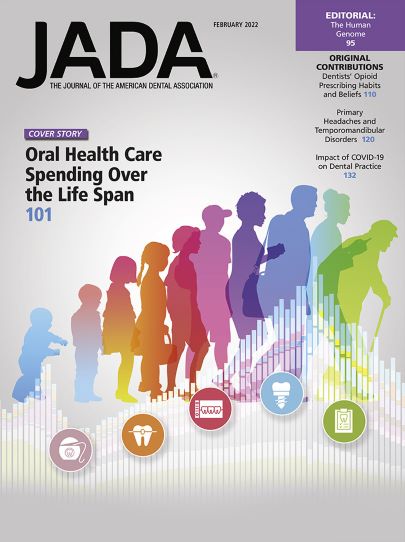Enter your email to receive the CareQuest newsletter:
February 11, 2022
CareQuest Institute for Oral Health researchers recently published an article in the Journal of the American Dental Association that offers one of the most in-depth explorations of lifetime spending on oral health care. The article appeared on the cover of the February 2022 issue, a signal of its importance to understanding how different populations access and receive care during their lives.
“Health policies should be focused on optimizing care delivery to provide effective preventive care at specific stages of the life span,” the authors wrote in the conclusion, “as opposed to policy development that is precipitated by short-term political and financial dynamics.”
How did the authors arrive at that conclusion?
To dive deeper into this topic, researchers hosted a webinar in January to explain the article’s key takeaway: that understanding and addressing the factors that impact oral health status and spending at every stage of life must ultimately influence how our oral health care environments are structured. Nearly 300 participants joined the webinar to learn more and ask questions about the research.
Understanding health outcomes over time goes beyond keeping track of how a childhood injury may still affect the body or how exposure to a disease could have long-term effects, the researchers explained. When considering oral health, the advantage of analyzing health over a lifetime is that you’re able to better understand how diseases, like caries, don’t just happen in a vacuum. Instead, health and disease patterns are in fact cumulative.
“If we keep focusing on the short term,” said Myechia Minter-Jordan, MD, MBA, president and CEO of CareQuest Institute, “we’ll continue to see the problems we face today: inequities and disparities in access outcomes.”
 The Spending Gap Between Public and Private Insurance
The Spending Gap Between Public and Private Insurance
Eric Tranby, PhD, director of analytics and data insights at CareQuest Institute, presented research data — from more than 31 million Medicaid claims and over 45 million commercial or Medicare supplemental claims — revealing the complexities of the current dental service environment and lack of equitable access to oral health care.
When looking at the people enrolled in Medicaid over a lifetime, data show three peaks in spending: two in childhood and one later in life. The first childhood peak is likely due to treatment for early childhood caries, Tranby explained. The second peak in early adolescence stems from orthodontics and oral surgeries. Then, people with dental coverage through Medicaid stop accessing care, usually around early adulthood. As they grow older, spending shifts away from the dental system and onto the medical system.
“Where we’re spending money, we’re spending money to treat oral health conditions in one place or the other, with Medicaid shifting some of that burden onto the medical system,” Tranby explained. “We see a very different pattern of spending over the life span of commercial insurance.”
By contrast, those with commercial insurance experience a very different spending pattern, in which the scale of spending is significantly higher — peaking at $600 per person per year versus Medicaid’s $300. This group still experiences a peak in childhood from orthodontic and oral surgery costs, but peaks related to caries are less likely later in the life span due to easier access to preventive care.
“Utilization is a function of both access and coverage, so it really is the way Medicaid is designed and commercial insurance is designed in this country that leads to patterns in spending and some of the outcomes that we’re seeing,” said Tranby. “There is really a missed opportunity in both insurance types, but particularly in Medicaid, to find ways to offset some of the costs of comprehensive dental coverage by knowing that we see cost savings on the medical side.”
How Changing Oral Health Care Delivery Transforms Patient Outcomes
Learning more about cost and structure of care delivery over a life span provides a better understanding of our health systems at large, and how oral health care impacts overall quality of life. It also points toward a solution that will ultimately allow for more equitable care and better outcomes for all.
“It’s like a kaleidoscope,” said Carolyn Brown, DDS, MEd, senior advisor on person-centered care at CareQuest Institute. “There are so many national and international programs focused on getting children the care they need so they’re not falling into that spending gap for preventive care.”
Focusing dental practices on preventive care means providers are looking first and foremost at patient outcomes, and not on costs. This puts patients on an equal playing field when receiving care, regardless of the type of insurance they have. CareQuest Institute’s Three Domain Framework is a great example of this, utilizing a value-based care approach that emphasizes person-centered care.
“Ultimately we need health policies that center people and optimize care delivery, whether you are 4 years old or 85 years old,” Dr. Minter-Jordan said. “If there’s one thing that I hope you take away from [this research], it is that we all have a responsibility to come together to create an accessible and equitable oral health system for all.”